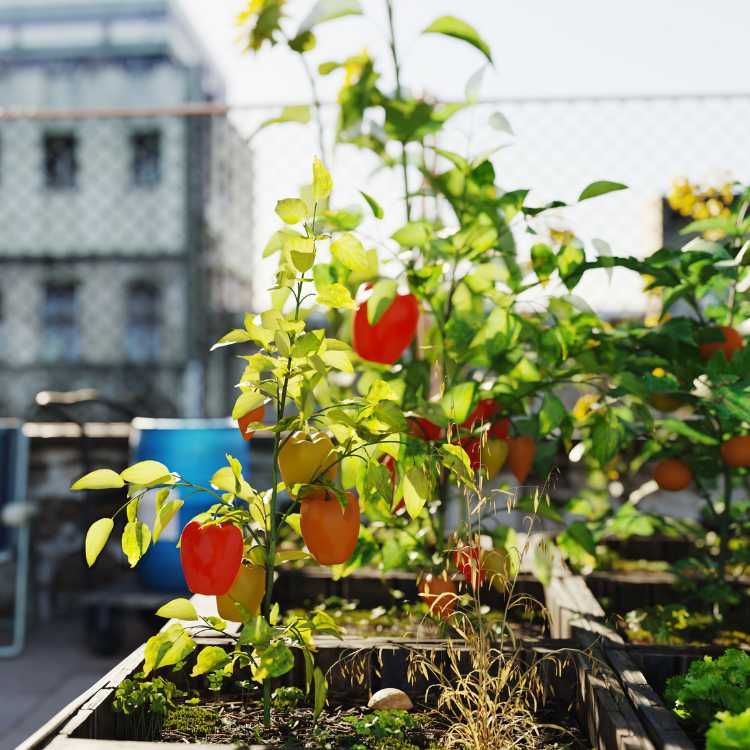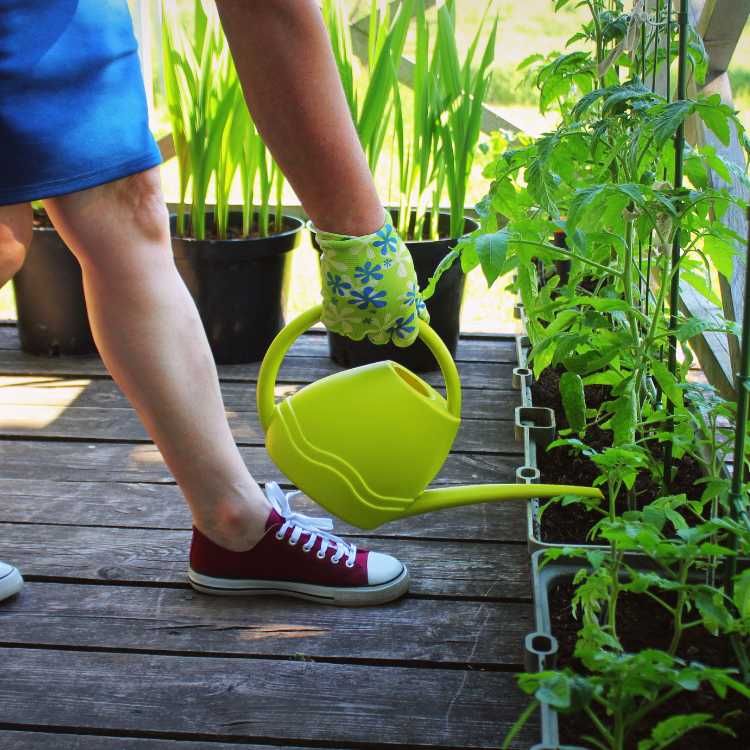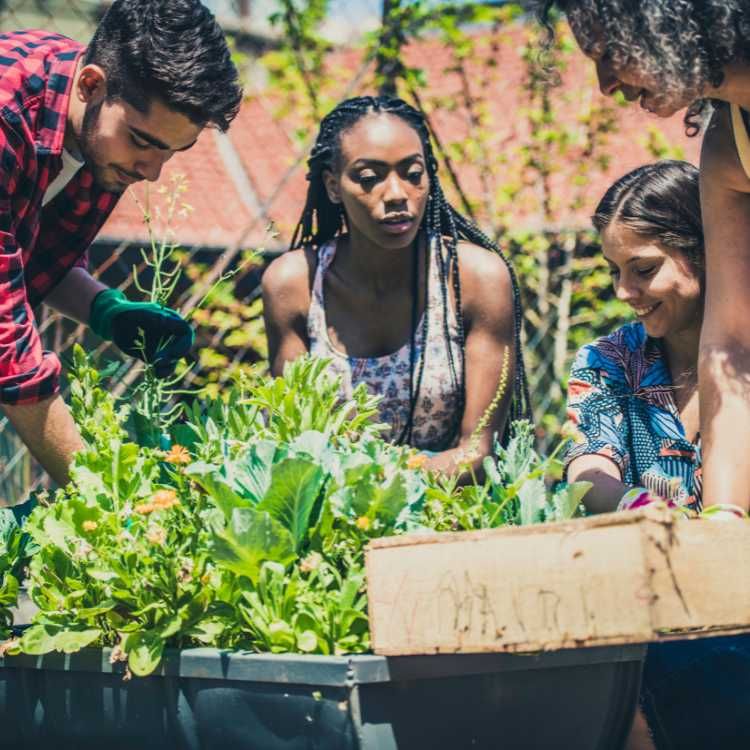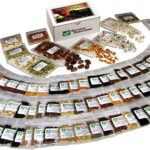
Key Takeaways
Identify sunny spaces, even on a small balcony, for your urban garden.
Choose resilient plants like herbs, leafy greens, and tomatoes for city growing conditions.
Utilize vertical gardens and container gardening to maximize limited space.
Engage with your community by starting or joining a community garden initiative.
Harvest your produce at peak ripeness for the freshest flavors straight from your balcony to your table.
Why Urban Gardening is Your Next Big Green Move
Imagine stepping outside onto your balcony to a burst of greenery, where tomatoes dangle from vines and fresh herbs release their fragrant aroma. This isn’t a scene from a rural homestead but from your very own urban dwelling. Urban gardening is transforming concrete spaces into lush, productive havens, and I’m here to guide you through making this green dream a reality.
Most importantly, urban gardening is about making the most of your space, no matter how limited, and enjoying the bounty of fresh produce that even a small plot can offer. Let’s dive into why tending to a garden amidst the hustle and bustle of the city isn’t just a hobby, it’s a lifestyle change that brings numerous benefits to your doorstep.
Grow Fresh Produce Amidst Concrete Jungles
Even in the heart of the city, you can cultivate a diverse range of fruits, vegetables, and herbs. The key is to start small and think creatively. Herbs like basil, cilantro, and mint are perfect for beginners and can thrive on a sunny windowsill. If you’re more adventurous, strawberries and cherry tomatoes are not only delicious but also add a splash of color to your urban landscape.
Because space is at a premium, selecting the right plants for your environment is crucial. Opt for varieties that are known for their resilience and adaptability to pot culture. This way, you’ll set yourself up for success from the very beginning.
Bring Life to Underused Urban Spaces
Every nook and cranny of your urban space holds potential for growth. That unused corner of your rooftop, the forgotten balcony, or even a windowsill can become a verdant spot that supports biodiversity and provides a much-needed refuge for city-dwelling wildlife like bees and butterflies.
Therefore, by introducing plants into these spaces, you’re not only enhancing your own living area but also contributing to the well-being of the local ecosystem. It’s a small step with a big impact, creating a ripple effect of positivity in your urban community.
Cracking the Concrete: Starting Your Urban Garden
Embarking on your urban gardening journey might seem daunting at first, but with a few simple steps, you’ll be on your way to harvesting your own produce in no time. Let’s break down the basics to get you started.
Initial Consideration of Space and Sunlight
Before you plant a single seed, assess the space you have available. How many hours of direct sunlight does it receive? Are there areas with partial shade that could accommodate plants with lower light requirements? These are the types of questions that will guide your plant selection and ensure your garden thrives.
Look for spaces that receive at least 4-6 hours of sunlight daily for most vegetables.
Use reflective surfaces to bounce light into shadier areas if necessary.
Remember, some leafy greens and herbs can tolerate less sun, making them ideal for balconies with limited light exposure.
After determining your sunlight situation, you’ll be better equipped to choose plants that will flourish in your urban garden.
Choosing Plants for Urban Environments
Selecting the right plants is crucial for urban gardening success. You’ll want to pick varieties that not only suit your available space and sunlight but also your personal taste. Here’s a tip: start with what you love to eat. There’s nothing more satisfying than snipping fresh basil for your pasta or plucking ripe strawberries straight from the plant.
Here are some top picks for urban gardens: discover the top 5 quick growth vegetables for your city space.
Herbs: Basil, cilantro, parsley, and mint are flavorful and easy to grow.
Leafy Greens: Spinach, kale, and lettuce thrive in cooler, shadier spots.
Vegetables: Cherry tomatoes, peppers, and radishes are compact and yield a good crop.
Fruits: Strawberries and dwarf citrus trees bring a sweet touch to your urban oasis.
With these plants, you can turn even the smallest urban space into a verdant paradise bursting with flavor.
Caring for Your Urban Oasis

Once your garden is planted, the real magic begins. Caring for your urban oasis is not just about routine maintenance; it’s about forming a connection with your plants and watching the fruits of your labor grow. The key to a thriving garden in the city is understanding the unique needs of your plants and creating a nurturing environment for them.
Watering Regimens for Potted Plants
Water is the lifeblood of your garden. In an urban setting, where natural rain might not reach your potted plants, establishing a consistent watering schedule is essential. Most potted plants prefer a thorough watering that allows moisture to reach the bottom of the pot, but be sure to let the soil dry out slightly between waterings. Overwatering can be just as harmful as under-watering, leading to root rot and other issues.
Combatting Pests and Ensuring Healthy Growth
Even in the city, pests can find their way to your precious plants. Keep an eye out for common culprits like aphids, spider mites, and whiteflies. A strong spray of water can dislodge many pests, and insecticidal soaps are a safe, effective treatment for infestations. Most importantly, healthy plants are the best defense against pests, so ensure your garden is well-fed and stress-free.
Remember to check your plants regularly for signs of disease or pests. Early detection means a greater chance of successfully treating the problem and keeping your garden lush and productive.
Space-Saving Techniques for Urban Gardening
Space is at a premium in urban environments, but with a bit of creativity, you can maximize your growing area. Techniques like vertical gardening and container gardening are not just practical; they can also add an aesthetic appeal to your space.
Vertical gardening utilizes the upward space that might otherwise go unused. Trellises, wall planters, and hanging baskets all offer ways to grow more in less space. Besides that, these methods can create a living wall that acts as a natural air filter and privacy screen.
Container gardening offers the ultimate flexibility. With containers, you can move plants to take advantage of changing sunlight patterns, and you can grow a variety of plants in a small area. Plus, containers can be anything from traditional pots to more inventive solutions like old buckets, barrels, or even upcycled furniture.
Example: A simple yet effective vertical garden can be created using a hanging shoe organizer. Fill each pocket with soil and plant herbs or strawberries for a space-saving and eye-catching garden feature.
Vertical Planting: Growing Upwards Not Outwards
Vertical planting is not just a clever solution for space constraints; it’s a statement. By using structures like trellises, you can train plants like cucumbers, peas, and even some types of squash to grow upwards. This method can yield a surprising amount of produce without taking up much ground space.
Vertical gardens can also be a work of art, adding greenery to walls and fences. They’re a great way to beautify your urban environment while also enjoying the practical benefits of homegrown food.
Container Gardening: Flexibility and Mobility
Container gardening is the epitome of urban gardening flexibility. Containers can range from small pots on a windowsill to larger planters on wheels that can be moved to chase the sun. They’re perfect for renters or anyone who might need to move their garden from time to time.
Rooted in Community: The Social Aspects of Urban Gardening

Urban gardening isn’t just about growing plants; it’s about growing communities. Gardens can be the thread that connects neighbors, fosters friendships, and builds a sense of shared purpose. When we garden together, we share more than just the harvest; we share experiences, knowledge, and the joy of creating something beautiful.
Creating Community Gardens: A Step-by-Step Guide
Starting a community garden can be a transformative project for your neighborhood. Here’s how to get started:
Find a suitable space, such as a vacant lot or shared rooftop.
Get permission from the property owner or city officials.
Organize a meeting with interested community members.
Plan the garden layout, considering the needs and wishes of the group.
Secure funding or donations for supplies and equipment.
Prepare the site and start planting!
With these steps, you can turn an underutilized space into a thriving community hub.
Joining Forces: Collaborating with Neighbors and Friends
Collaboration is at the heart of urban gardening. Whether it’s sharing seeds, swapping gardening tips, or helping each other with watering duties, working together makes the gardening experience richer. Besides that, it’s a great way to learn from one another and celebrate the diverse knowledge within your community.
Therefore, reach out to your neighbors or local gardening clubs to start building your urban gardening network. You’ll find that the support and camaraderie are as rewarding as the harvest itself.
The Fruits of Your Labor: Harvesting and Enjoying Your Produce
One of the greatest joys of urban gardening is the moment you get to harvest your produce. There’s a sense of pride and accomplishment that comes from nurturing plants from seed to table. When you bite into that first crisp lettuce leaf or juicy tomato, all the effort you’ve put into your garden feels worth it.
When and How to Harvest Your Urban Bounty
Harvesting at the right time is crucial for the best flavor and yield. Most leafy greens can be picked when they’re tender, while root vegetables like carrots and radishes should be harvested when they reach the desired size. For tomatoes, wait until they’re fully colored and slightly soft to the touch.
Remember, regular harvesting encourages plants to produce more, so don’t be shy about snipping those herbs or picking those peppers. It’s all part of the garden’s natural cycle of growth and regeneration.
From Garden to Table: Fresh Recipes for Your Harvest
Your urban garden’s produce can inspire a world of fresh, healthy recipes. Imagine a salad made with your own lettuce, cucumbers, and cherry tomatoes, or a pesto crafted from homegrown basil. The possibilities are endless, and the flavors are unmatched.
Here are some simple ideas to enjoy your harvest:
Blend leafy greens into smoothies for a nutritious breakfast boost.
Top homemade pizzas with fresh herbs and vegetables for a gourmet touch.
Pickle your cucumbers or make salsa with your tomatoes and peppers for a homemade treat.
With these tips and a bit of ingenuity, your urban garden will not only be a source of sustenance but also a wellspring of culinary creativity.
Technology Meets Nature: Leveraging Apps for Garden Management
As city gardeners, we’re always looking for ways to streamline our routines and stay organized. Thankfully, technology is on our side. With a host of gardening apps available, you can track your garden’s progress, set watering reminders, and get personalized advice for plant care. These digital tools bring a wealth of knowledge right to your fingertips, making urban gardening more accessible than ever.
Top Gardening Apps for Urban Green Thumbs
Whether you’re a seasoned gardener or just starting out, there’s an app to help you grow your urban oasis. For those living in apartments, consider exploring options like hydroponics systems to maximize your space efficiently.
Planta: This app provides care tips and watering schedules for your specific plants.
Garden Manager: Set alarms for watering and fertilizing, and track your garden’s growth.
GrowIt!: Connect with a community of gardeners to share tips and get plant identification help.
With these apps, you’ll be equipped to manage your urban garden like a pro, ensuring that every plant gets the attention it needs to thrive.
Tracking Plant Growth and Health Digitally
Using an app to monitor your garden’s progress is not only convenient, it’s also incredibly rewarding. You can log each plant’s growth, celebrate milestones, and even keep a photo diary. This digital logbook will not only serve as a practical tool but also as a beautiful archive of your gardening journey.
Frequently Asked Questions
As you cultivate your city oasis, questions are bound to arise. Here are answers to some common queries that can help keep your urban garden flourishing:
Can I start an urban garden without a balcony or rooftop?
Absolutely! You can grow an indoor garden using containers or hydroponic systems. Just make sure you place your plants in an area that receives sufficient sunlight, like a windowsill, or use grow lights to supplement.
What are the fastest-growing vegetables and herbs for an urban garden?
For quick results and gratifying gardening, consider these fast growers:
Herbs: Basil, cilantro, and dill can be ready to harvest in just a few weeks.
Salad Greens: Lettuce, spinach, and arugula can be harvested as microgreens or allowed to grow full size.
Radishes: These crisp root veggies can be ready in as little as a month.
These plants are perfect for giving you a quick taste of success in your urban garden.
How often should I fertilize my urban garden plants?
Fertilizing schedules depend on the plant type, but a general rule is to fertilize every four to six weeks during the growing season. Always follow the instructions on your fertilizer, and remember that less is more—you can always add more if needed.
What are the best practices for urban composting?
Composting in a city setting can be a bit tricky, but it’s definitely doable. Here are some best practices:
Use a sealed container to prevent odors and pests.
Balance your greens (food scraps) and browns (dry leaves, paper) for effective composting.
Regularly turn your compost to aerate it and speed up the decomposition process.
With these tips, you can create rich, nutritious compost for your urban garden without any hassle.
How can I attract pollinators to my urban garden?
Pollinators are essential for a healthy garden, and attracting them can be as simple as planting the right flowers. Choose native plants, which are naturally more attractive to local pollinators. You can also provide a water source and avoid using pesticides, which can harm these beneficial creatures.
By following these tips, your urban garden will not only be a lush oasis for you but also a welcoming haven for pollinators.
Urban gardening is a rewarding venture that brings the beauty of nature into the heart of the city. With the right approach, a bit of creativity, and the help of technology, you can transform any urban space into a productive and tranquil green retreat. From selecting the right plants to harvesting your homegrown produce, every step in the gardening process is an opportunity to learn, grow, and connect with the environment. So roll up your sleeves, get your hands dirty, and start cultivating your very own city oasis today!
And if you’re looking to take your urban gardening to the next level, don’t forget to check out Survival Essentials for a wide range of heirloom seeds and gardening supplies. Whether you’re expanding your balcony garden or starting a community project, they’ve got everything you need to ensure your urban garden is a success.







Leave a Reply